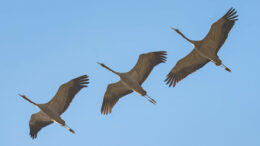This spring, as Russian missiles and drones continued to rain destruction upon Ukraine, a more hopeful symbol appeared in the skies about the embattled nation.
The cranes had returned.
Every March and April, these elegant, long-necked birds migrate into the marshes, lakes and steppes of Ukraine, where they build nests and spend several months resting and eating before flying off for winter. Two crane species arrive each year: the common or gray crane (Grus grus) and the demoiselle or steppe crane (G. virgo). The critically endangered Siberian crane (Leucogeranus leucogeranus) has also been known to visit the country.
The cranes’ annual spring arrival is normally cause for celebration in Ukraine.
“The Ukrainian people have always revered the crane as a bird of general happiness and joy,” says Olga Chevganiuk, head of international department at UAnimals, Ukraine’s largest animal-rights organization, which has helped evacuate thousands of animals from warzones. “The birds were addressed with requests for a harvest, health, and wellbeing in the family.” Witnessing cranes in spring was seen as a portent of an upcoming wedding, and weddings themselves are often celebrated with a crane-inspired folk dance.
“These birds dance beautifully, and not only during the mating season,” Chevganiuk says. “They use their elegant bows and jumps, and sometimes wild and funny movements, to communicate as a family.”
For other people around the world, cranes mean something bigger: peace. For the past few years, hundreds of individuals, church groups and other community efforts have folded thousands of blue and gold origami cranes to signify their support for the Ukrainian people.
This year Ukraine could use the support — and the cranes — more than ever. “Cranes are the personification of our desires and balance, which we need so much now,” Chevganiuk says. Their arrival in March coincided with Russia’s destruction of the country’s largest hydroelectric dam, something one Ukrainian official tells me has caused another “ecological disaster” for a landscape already scarred by bombs and invading forces.
The cranes themselves have felt some of the effects of war, especially on Crimea, the Ukrainian peninsula Russia first invaded in 2014. Other crane habitats affected by the conflict include the Donetsk region, Kherson and Zaporizhzhia, says Yury Andryushchenko, doctor of biological sciences and head of the Laboratory of Ornithology of Southern Ukraine. “Active ‘maneuvers’ of a large number of occupiers are taking place in these territories,” which have seen military fortification and fierce battles over the past two years.
The damage to crane habitats around Ukraine has been significant, according to accounts from other publications and conservation organizations. BirdLife reported in August 2022 that “[as] a result of bombings and rocket attacks, there have been large-scale forest fires (Chornobyl zone) and fires in the reed thickets in river floodplains (Azov-Black Sea region) destroying the habitats of forest bird species,” including the common crane. “In the Kherson region, along the shores of the Azov and Black Seas, fires ignited by artillery and mines destroyed reed thickets and imperiled the habitats of birds such as the Demoiselle crane, a species considered endangered in Europe,” Audubon magazine reported last fall.
Numerous other bird species have also been affected by the war, Andryushchenko says, including steppe larks and several kinds of woodpecker. “The most negative impact on the avifauna occurs directly during hostilities, which lead to scaring, injury and death of birds or their clutches and broods, disruption of the daily cycle, destruction of housing, etc.,” he says. The Ukrainian Nature Conservation Group has identified dozens of bird species threatened by the invasion.

As with all acts of war, the damage goes far beyond the bombs and bullets.
“Birds are not only directly affected by hostilities,” Andryushchenko says, “but also by the military and other activities — providing troops with weapons, ammunition and food; repairing equipment, roads and various structures like bridges, pipelines and towers; mining, digging trenches and building fortifications. In addition, simply by the movement of military personnel and military equipment.”
Assessing that damage will take time — and it won’t happen immediately. “In order to find out the specifics of the impact of the war on the steppe crane population, it is necessary to conduct appropriate research in this occupied area,” Andryushchenko says. “We will certainly do this after our victory.”
And with that statement, cranes embody hope once again.
Get more from The Revelator. Subscribe to our newsletter.
![]()
Previously in The Revelator:
In Ukraine, Saving Wildlife Harmed by War



